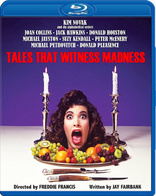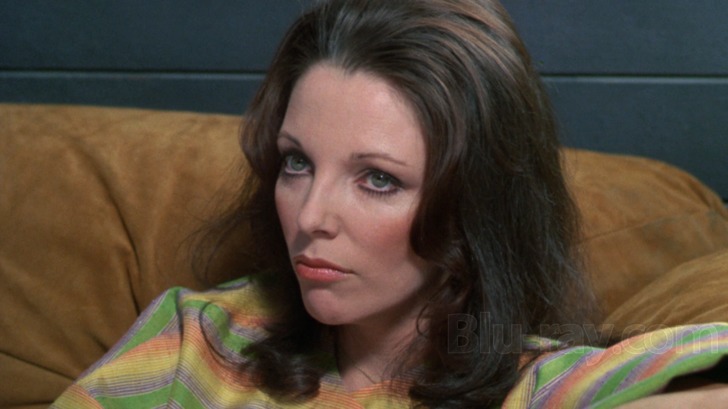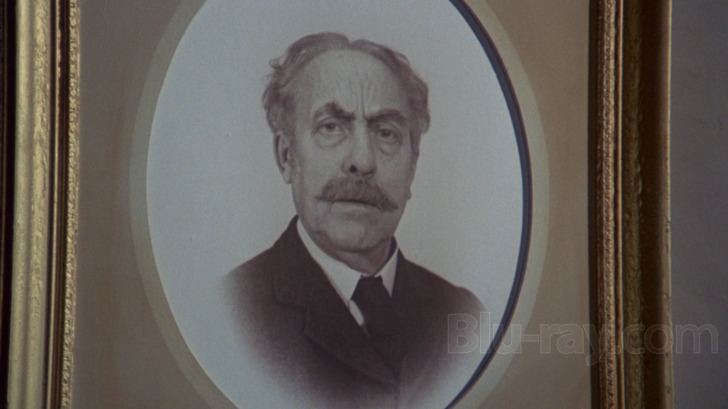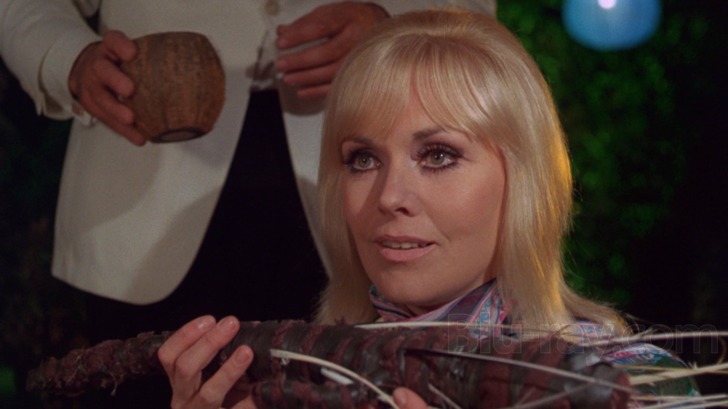Tales That Witness Madness Blu-ray Movie
HomeTales That Witness Madness Blu-ray Movie 
Olive Films | 1973 | 90 min | Rated R | Jun 26, 2012
Movie rating
6.2 | / 10 |
Blu-ray rating
| Users | 0.0 | |
| Reviewer | 3.5 | |
| Overall | 3.5 |
Overview
Tales That Witness Madness (1973)
At a private clinic devoted to the study of mental illness, Dr. Tremayne invites his friend and associate Nicholas to hear of his breakthrough theory developed from the study of four patients, each of whom was involved in a murder. Tremayne introduces the patients to Nicholas individually and shares their stories.
Starring: Donald Pleasence, Jack Hawkins (I), Joan Collins, Donald Houston, Michael JaystonDirector: Freddie Francis
| Horror | Uncertain |
| Mystery | Uncertain |
| Dark humor | Uncertain |
Specifications
Video
Video codec: MPEG-4 AVC
Video resolution: 1080p
Aspect ratio: 1.78:1
Original aspect ratio: 1.85:1
Audio
English: DTS-HD Master Audio Mono
Subtitles
None
Discs
25GB Blu-ray Disc
Single disc (1 BD)
Playback
Region A, B (C untested)
Review
Rating summary
| Movie | 3.0 | |
| Video | 3.5 | |
| Audio | 3.5 | |
| Extras | 0.0 | |
| Overall | 3.5 |
Tales That Witness Madness Blu-ray Movie Review
Tales designed to drive you. . .mad!
Reviewed by Jeffrey Kauffman June 14, 2012The little British production house (actually founded by two expat Americans) Amicus became famous for its so-called portmanteau horror productions, so famous in fact that many people think the genre originated with the studio. Portmanteaus, films which offer short vignettes that are tied together with bridging segments, had of course been around virtually since film began, at least in one form or another. While the term portmanteau came to be associated with horror films (especially with regard to the Amicus brand), there are scores of films outside of the horror genre that share at least some elements in common with traditional portmanteau structure. With regard to horror films, one of the most famous portmanteaus is the chilling Ealing Studios 1945 film Dead of Night, a production that shares more than a passing resemblance to the 1973 British horror opus Tales That Witness Madness, a film that is often mistakenly branded with the Amicus label but which was in fact a World Film Services presentation that was distributed stateside by Paramount. Tales That Witness Madness also harkens back to one of the very earliest horror films, the iconic 1920 silent The Cabinet of Dr. Caligari, though in the interests of discretion, certain correlations won’t be mentioned so that those who haven’t seen either that film or the one currently under discussion won’t have twists revealed. Tales That Witness Madness takes place in an ultra-modern insane asylum, a glistening white expanse of hallways that recalls the denuded environments of the space station in Kubrick’s 2001: A Space Odyssey. A visiting psychiatrist (Jack Hawkins) has arrived to congratulate the asylum’s director (Donald Pleasance) on what seems to have been a recent breakthrough in treating four problem cases. Pleasance then leads Hawkins from room to room (actually, cell to cell) and recounts the case histories of each of the four subjects in question, leading to the traditional portmanteau structure.

There’s a certain amount of goofiness that runs through Tales That Witness Madness, a just slightly dry sense of humor that is rather reminiscent of a television portmanteau, Rod Serling’s Night Gallery, a series which, unlike The Twilight Zone, typically featured more than one segment bridged of course by Serling’s walks through a demonic art gallery. Also like Night Gallery, the segments here are highly variable and some don’t offer exactly surprising twists. Probably the most predictable of the set is the film’s opener, a kind of unseemly tale of bickering parents (one of whom is Georgia Brown, the original Nancy in the West End and Broadway versions of Oliver!) whose son has forged a friendship with an imaginary playmate. This is no typical imaginary playmate, however, it’s a tiger, which of course neither of the parents (who can’t lay eyes on one another without breaking into a heated argument) believes. Three guesses what happens to the parents in the episode’s gruesome climax.
The next episode is somewhat more interesting and less predicable, and it in fact utilizes a piece of art—albeit a photograph—much like Night Gallery used to. Timothy (Peter McEnery) has inherited a bunch of stuff from his deceased and evidently quite dotty Aunt, including an old Penny Farthing (one of the huge-wheeled bicycles that were part of the iconography of the Patrick McGoohan series The Prisoner) and a photograph of Timothy’s pompous Uncle Albert (Frank Forsyth). The photograph seems to have a mind of its own, as evidenced by the various poses it assumes throughout the episode, one of which involves glaring eyes which seem to such Timothy toward the Penny Farthing, literally lifting him into the air and depositing him on the cycle, which then rather incredibly becomes a time machine, taking Timothy back to what looks like Edwardian times. There, he has become Albert as a young man, where he meets a woman who looks surprisingly like his wife Ann (Suzy Kendall) but who seems to be involved in an illicit affair with Albert. This episode has all the hallmarks of a fun time travel story, but it’s too rushed to ever fully develop its content, and it devolves into some silly histrionics at its climax.
The always reliable Joan Collins shows up in the third episode as Bella, the increasingly jealous wife of Brian (Michael Jayston, rather incredibly appearing in this film a mere two years after having starred in Nicholas and Alexandra), although the source of her jealousy is a bit unusual: it’s a dead tree Brian has brought home and ensconced in their “modern” (meaning early seventies chic) home in the woods. Brian notices an inscribed name on the tree’s trunk and begins calling the tree by that name, Mel, slowly seeming to come under the spell of some spirit inhabiting the tree. Bella isn’t about to just stand by and see herself bested by a bunch of dead wood, and fireworks ensue. This is frankly a patently silly episode, but it’s weirdly enjoyable, especially with the decidedly lo-fi “special effects’, which see little moments like Mel “turning” to “face” Brian or Bella. Mel herself is rather a bizarre looking creature as well, adding to the surreality of this outing.
The last episode is unfortunately not very effective, due largely to the miscasting of Kim Novak as an insanely ambitious literary agent who isn’t much pleased that her new client is showing an untoward interest in her daughter. That actually plays to her advantage due to a scheme that her client’s aide brings to her with regard to how to plan a lavish luau. The elements here are actually great, in a Grand Guignol sort of way, and the denouement is appropriately disturbing, but Novak has neither the menace nor the sly, winking humor that’s needed for an approach like this, and as a result the episode plays more like parody than anything else. (Evidently Novak was a last minute replacement for Rita Hayworth, which may at least partially explain her inadequacy in the role.)
We return to the framing device as Tales That Witness Madness concludes, with the two psychiatrists involved in a discussion about methods and madness. There are not one but two little surprises bring the film to a close. This is probably not top tier Freddie Francis, a director who had initially made his name as a top cinematographer before carving out his little niche in horror films like this (he would return to cinematography again later and do a number of high profile projects like David Lynch’s The Elephant Man). But there’s a degree of campy fun running through this piece which exonerates it from some of its built in weaknesses. Any film that has Alexis Carrington Colby duking it out with a tree certainly has something very special to offer a certain class of discriminating viewer.
Tales That Witness Madness Blu-ray Movie, Video Quality 

Tales That Witness Madness is presented on Blu-ray courtesy of Olive Films with an AVC encoded 1080p transfer in 1.78:1. This is a decently sharp looking Paramount catalog release that continues the Olive tradition of no digital tweaking, resulting in a very filmlike appearance, with natural grain and a kind of florid early seventies film stock ambience. Colors are rather well saturated, though reds tend to bloom ever so slightly and drift precariously close to orange some of the time. The image is above average in sharpness and clarity and the elements are surprisingly damage free. Contrast is stable and black levels are generally quite good.
Tales That Witness Madness Blu-ray Movie, Audio Quality 

Tales That Witness Madness' lossless DTS-HD Master Audio Mono mix is quite satisfying given appropriate expectations. Dialogue is crisp and clean, though alert viewers and listeners will notice a few minor synch problems that were no doubt endemic to the original source elements, especially with regard to Jack Hawkins, who had had his larynx removed by that point and was dubbed for the film. While narrow and shallow, the track boasts fairly fulsome low end and midrange and several piquant screams deliver good high end as well. There's no damage of any major kind to report on this track other than a bit of hiss.
Tales That Witness Madness Blu-ray Movie, Special Features and Extras 

As is the Olive standard operating procedure, no supplements of any kind are included on this Blu-ray disc.
Tales That Witness Madness Blu-ray Movie, Overall Score and Recommendation 

Tales That Witness Madness is a silly little film but it's also good fun, at least in dribs and drabs. The film suffers from the very episodic nature that defines a horror portmanteau, with the time travel episode suffering the most, especially since in some ways it's the most effective bit of the bunch. But even with its built in ridiculousness, there's a lot to enjoy here, especially if it's approached with a certain dry sense of humor. As is usual with a Freddie Francis film, it's handsome and well shot if never exceedingly subtle. This Blu-ray offers very good video and audio and even without supplements it comes Recommended.
Similar titles
Similar titles you might also like

Blair Witch
2016

Scared Stiff
1987

Asylum 4K
1972

Weird Woman
1944

I Bury the Living
1958

The Four Skulls of Jonathan Drake
1959

King of The Zombies
1941

Children Shouldn't Play with Dead Things
50th Anniversary Edition
1973

Retribution
Retribution: The Ultimate Nightmare
1987

V/H/S: Viral
2014

Dr. Terror's House of Horrors 4K
Slipcover in Original Pressing
1965

Child's Play 4K
1988

The House That Dripped Blood
1971

The Plague of the Zombies
1966

Stephen King's The Langoliers
1995

Antebellum
2020

Daniel Isn't Real
Slipcover in Original Pressing
2019

The Dead Center
2018

Dan Curtis' Dead of Night
1977

The Ghost Breakers
1940